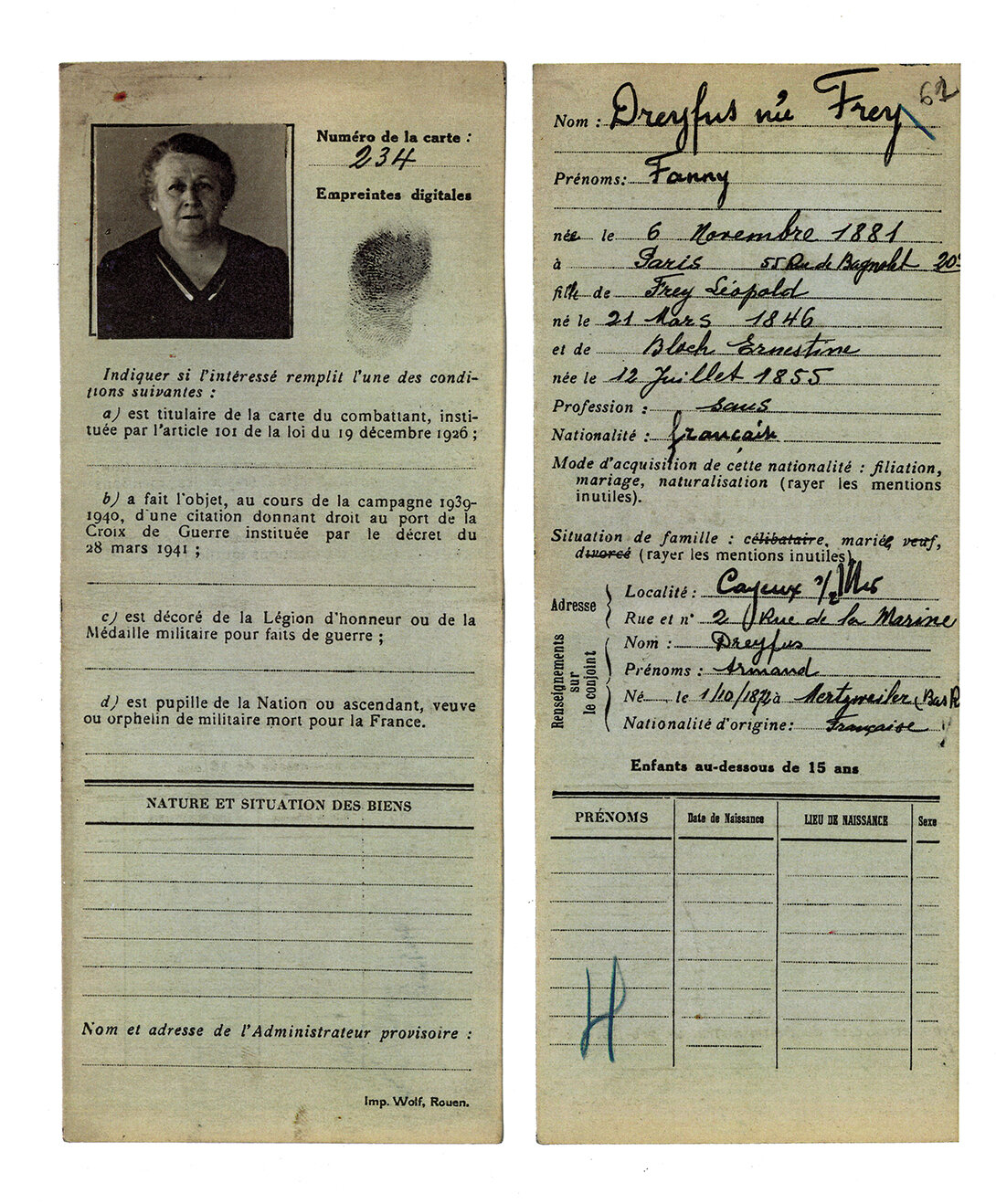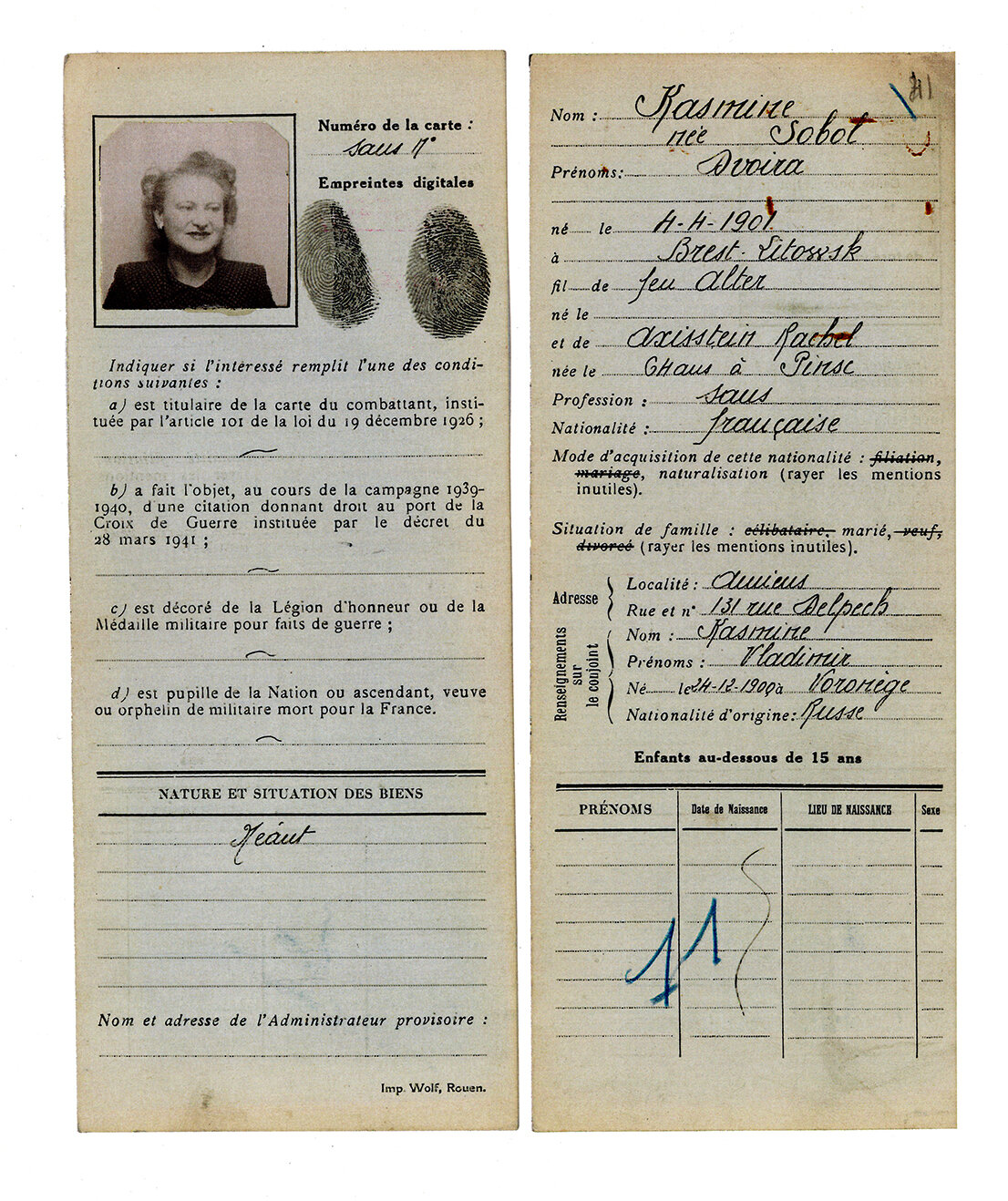Jews of the Somme
Être Juif dans la Somme
Who is a Jew? Amiens, France, 1940-45
This exhibit was first presented at Temple Emanuel of the South Hills, in Pittsburgh, Pennsylvania, March 2018-May, 2019 in Thou Art Gallery. Subsequent versions have been presented at various venues in the U.S. and France.
Amiens, the capital of the Department of the Somme (shown in red), lies seventy-two miles north of Paris en route to the English Channel. I have been studying the history of the Jewish community there for a number of years.
This exhibit is organized around a group of identification cards discovered in the summer of 2017 in the course of my research. Along with the exhibit, there are handouts available, which provide additional information, including what happened to the people pictured, that could not be covered adequately in the available space. The handouts also explore in greater depth questions of identity and definition.
Between 1870 and 1940, there were no official French government records to indicate who was a Jew. When the German armies occupied the country, they issued a law, September 27, 1940, requiring all Jews to register with the police or local government official on pain of fine or imprisonment or confiscation of property. This measure defined a “Jew” as someone who was “affiliated with the Jewish religion;” or someone who had “more than two grandparents who were affiliated with the Jewish religion.”
The law was announced on the front page of the local newspaper. The “Registry of Persons declaring as Jews,” pictured below, contained such categories as name, date of birth, place of birth, occupation, address, years of residence in France, marital status and “confession.” This last category was confusing to contemporaries. Did it matter in the eyes of the authorities if you were a religious, i.e. practicing Jew? A few people identified themselves as “Israelites” apparently meaning affiliated, practicing Jews. Many more said they were “non-practicing” (“non-pratiquant”) or none (“néant”). A few described themselves as “Catholic,” the religion of the majority, presumably because they had been converted to Catholicism at some point.
Throughout the Occupation the authorities constructed numerous lists and files to keep track of the movements of Jews in and out of their jurisdictions. The individual file cards or fiches shown in the next few panels of this exhibit were compiled in or around June 1942 by the police in Amiens and by local government officials elsewhere in the Department of the Somme. I discovered them on a roll of microfilm in the summer of 2017 at the Documentation Center of the Holocaust Museum in Paris. Being on the lists opened you up to various forms of discrimination and isolation and was increasingly dangerous as Jews started to be deported to the “East.”
First page of Registry with signatures of heads of households
Façade of the WWII-era synagogue in Amiens
Cover of “Registry of Persons declaring as Jews” [1940]
German ordinance of September 27, 1940, requiring French Jews to register
Samuel Obeler and Jeanne Coinon made unsuccessful efforts to have their names removed from the lists.
June, 1942, when the fiches in this display were compiled, was the midpoint of the German Occupation of France. It was also a turning point, after which matters took a calamitous turn for the Jews of the Somme. Starting in June, Jews were required to wear a large yellow star of David with the word “Juif” (“Jew”) on their garments whenever they appeared in public.
Source for fiches : Archives nationales de France (Pierrefitte-sur-Seine), AJ 38 5787
Click on an image to expand it and scroll through the image gallery.
Many Jews had their property and businesses confiscated or sold.
Armand and Fanny Dreyfus lost their general store in Cayeux-sur-Mer
On July 16-17, 1942, French police rounded up thirteen thousand Jews of Paris. An estimated 7,000 were crowded into an unused sports stadium, the Velodrome d’Hiver, under atrocious conditions. From there many were sent to transit camps and then to Auschwitz or Sobibor. Jews from Amiens and the Somme were rounded up, too, on July 18-19, 1942. Some of the fiches have annotations on them indicating the status of these individuals. “Interné” means they were sent from Amiens to Drancy, the camp for the Jews outside Paris. From there they were shipped in convoys of cattle cars to the extermination camps.
Non-naturalized foreign-born Jews, like the Redlichs and the Lewenbergs, originally from Poland, and Marc Adler, from Luxembourg, suffered this fate in 1942 along with Georges Wolff from Germany and Ernest Rado from former Czechoslovakia. Of those not arrested in 1942, many—whether native French Jews or naturalized French Jews—were rounded up between January 4-9, 1944. This included, tragically, three children. A fourth child, Jeannine Khaiëte, arrested in July 1942, was deported with her parents in March 1943.
Some Jews of the region escaped the roundups. Samuel Obeler returned after the war to take his place on the Amiens city council. Lucien Aaron resumed his business and momentarily the leadership of the Jewish community. Ginette Schulhof went on to a career as a philosophy teacher. Those who survived were marked forever by the loss of loved ones and the experience of radical persecution.
I first came to Amiens in 1973 to pursue research on a dissertation on 16th century religious history. Since 2011, I have been working with government and community leaders, archivists, teachers and students in Amiens to bring attention to the history of the Jewish community in that part of France. Recently, this initiative resulted in the dedication of a memorial plaque by the city of Amiens at the site of the WW II-era synagogue.
I wish to acknowledge the assistance of Caroline Piketty of the National Archives of France, who graciously provided me with high quality photocopies of the identification cards from series AJ 38. I want to thank Lydia Rosenberg for her knowledge and skill in designing this exhibit, and Leah Mackin for important and patient preliminary work.
David Rosenberg received a Ph.D. in European History from Yale University with a dissertation on the Protestant movement in Amiens in the 16th century. After a decades long engagement with that particular city and its history, Dr. Rosenberg embarked in 2011 on the study of the fate of its Jewish community especially during the Shoah. As a byproduct of his research, Rosenberg consulted with the Departmental Archives of the Somme to enrich their holdings and digital representation of Jewish-related materials. With daughter Lydia Rosenberg and Jared Miller, he created a website containing several hundred scans of original documents related to the Jews of the Somme during the Occupation with introductions in English www.jewsofthesomme.com David Rosenberg also holds a Master’s Degree in Library Science with an Archives specialization from the University of Pittsburgh and is a member of Temple Emanuel.
David Rosenberg alongside Mayor Brigitte Fouré, for the unveiling and dedication of the plaque, October 22, 2017.
























































